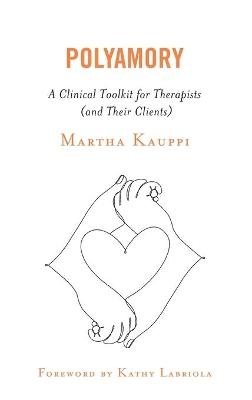
Polyamory
Rowman & Littlefield (Verlag)
978-1-5381-2988-3 (ISBN)
This is the first practical, how-to guide to non-monogamy for therapists. It contains everything a therapist needs to know to start working confidently and competently with polyamorous clients. It covers both the most common challenges and the most complex and difficult situations likely to present in the therapy room. In addition, worksheets and checklists are included to help guide therapists in the therapy room.
Martha Kauppi, LMFT, ACST, is a marriage and family therapist, speaker, educator, AASECT-certified sex therapist, and AAMFT-approved supervisor. She is the founder of the Institute for Relational Intimacy, a series of online and in-person courses and workshops for therapists on working effectively with complicated sex issues, relational issues, and alternative sexualities. Kauppi holds a Masters in Marriage & Family Therapy, Edgewood College, Madison, WI.
Table of Contents
Acknowledgements
Introduction
Section 1: Polyamory from a therapist’s perspective
Chapter 1: Consensual non-monogamies: what are the options?
Chapter 2: Polyamory; who, what, why
Chapter 3: Overlapping marginalized populations and intersectionality
Chapter 4: Polyamory theory or why polyamory makes sense to some
Chapter 5: Who can benefit from consensual non-monogamy?
Section 2: Creating a strong foundation for therapy with polyamory
Chapter 6: The therapist: bias, strengths, and challenges
Chapter 7: What makes a good relationship?
Chapter 8: Conceptualizing the case: if polyamory isn’t the problem, what is?
Chapter 9: Using the Initiator/Inquirer Process to support differentiation and move toward decisions
Chapter 10: Getting polyamory therapy off to a strong start
Section 3: Polyamory in the therapy room: common presenting problems
Chapter 11: Negotiating polyamory: forming good agreements
Chapter 12: Negotiating polyamory: talking points for partners
Chapter 13: Understanding and addressing jealousy
Chapter 14: Infidelity, broken agreements, and building trust
Chapter 15: Working with reluctant polyams and mono-polyams
Chapter 16: Recovering from polyamory gone wrong
Chapter 17: Role-related challenges and benefits: primaries, secondaries, hinges
Chapter 18: Relationship transitions: new relationships energy, relationship decisions, shifting between partners, and breakups
Chapter 19: Polyamorous families with children, and coming out issues
Section 4: Professional considerations
Chapter 20: Ethical considerations
Chapter 21: Marketing yourself as a polyamory-friendly therapist
Section 5: Worksheets, Exercises, and Handouts
My relationship ideas: reflection worksheet (included in chapter 6)
Relationship structures: imaginative reflection (included in chapter 7)
Dreams and desires (included in chapter 7)
Daily practice identifying thoughts and feelings (included in chapter 8)
Needs versus desires (included in chapter 8)
Preparing to communicate (included in chapter 8)
Rehearsing tough conversations (included in chapter 8)
Accessing motivation (included in chapter 8)
Holding steady self-coaching worksheet (included in chapter 8)
Time out handout (included in chapter 8)
Initiator (copyright The Couples Institute, pdf) (referenced in chapter 9 and could also be included there)
Inquirer (copyright The Couples Institute, pdf) (referenced in chapter 9 and could also be included there)
30 Ideas no matter how silly brainstorming process (included in chapter 9)
How to get the most out of relationship therapy handout (included in chapter 10)
Getting clear on your goals (included in chapter 10)
Feelings about polyamory and monogamy (included in chapter 12)
Big picture relationship musings (included in chapter 12)
Imagining many forms of open (included in chapter 12)
Discussion points for partners with shared responsibilities (included in chapter 12)
Managing information and emotional boundaries (included in chapter 12)
Consolidating information, working toward action (included in chapter 12)
Challenging your narrative assumptions (included in chapter 13)
Co-creating a trusting relationship (included in chapter 14)
How I plan to handle new relationship energy (included in chapter 18)
Resolving a dilemma using two chairs (included in chapter 18)
| Erscheinungsdatum | 10.05.2021 |
|---|---|
| Verlagsort | Lanham, MD |
| Sprache | englisch |
| Maße | 166 x 237 mm |
| Gewicht | 953 g |
| Themenwelt | Sachbuch/Ratgeber ► Gesundheit / Leben / Psychologie ► Partnerschaft / Sexualität |
| Geisteswissenschaften ► Psychologie ► Familien- / Systemische Therapie | |
| Medizin / Pharmazie ► Medizinische Fachgebiete ► Psychiatrie / Psychotherapie | |
| ISBN-10 | 1-5381-2988-4 / 1538129884 |
| ISBN-13 | 978-1-5381-2988-3 / 9781538129883 |
| Zustand | Neuware |
| Haben Sie eine Frage zum Produkt? |
aus dem Bereich


